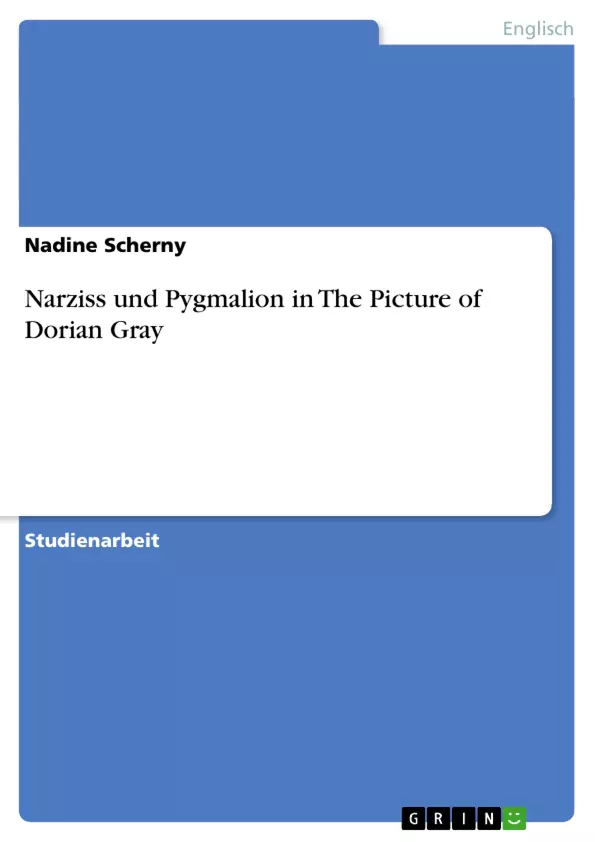[...] Des Weiteren finden wir einen Mythos, den Wilde ebenfalls hat einfließen lassen, nämlich den des Bildhauers Pygmalion (met.X.243-97). Dies ist jedoch nicht sofort ersichtlich, da er nicht wie Narziss ausdrücklich genannt wird. Trotzdem kann anhand mehrerer Textstellen dessen Präsenz deutlich gemacht werden. Die folgende Szene beschreibt, wie der Künstler Basil Hallward in seinem Atelier vor einem seiner Werke, einem lebensgroßen Porträt eines jungen Mannes, sitzt und es bewundernd betrachtet. Es ist ihm gelungen, sein Modell in dem Bild treffend wiederzugeben und ist fasziniert von dessen Schönheit: „In the centre of the room [...] stood the full- length portrait of a young man of extraordinary personal beauty, and in front of it [...] was sitting the artist himself, Basil Hallward [...] As the painter looked at the gracious and comely form he had so skilfully mirrored in his art, a smile of pleasure passed across his face [...]” (140). Im folgenden Passus zeigt sich die langsame Verwandlung des Bildes: „He [...] went over to the picture, and examined it. [...] [T]he face appeared to him to be a little changed. [...] One would have said that there was a touch of cruelty in the mouth” (240) “[...] [T]here was no doubt that the whole expression had altered” (240f.). Wilde gelingt es meisterhaft, durch die Ähnlichkeit der Motive und die Tatsache, dass die Hauptfigur Dorian gleichzeitig Narziss und Pygmalion-Statue darstellt, beide Mythen fließend ineinander übergehen zu lassen. Die folgende Arbeit soll im ersten Teil eine kurze Übersicht über die ovidischen Traditionen geben und sich im Folgenden damit beschäftigen, welche wichtigen Motive der Mythen1 Wilde in seinem Roman einsetzt und wie er diese ve rarbeitet. Problematisch dabei ist, dass die Mythen unter den einzelnen Gesichtspunkten wegen der sich aus Dorians Doppelrolle ergebender Verbindung von Pygmalion- und Narziss-Aspekten nicht getrennt untersucht werden können. Abschließend soll ein bündiger Abriss über Wildes Werk im Spiegel des Fin de siécle gegeben werden, um einen Zusammenhang zwischen der Interpretation der Mythen und der Epoche einleuchtend zu machen.
Inhaltsverzeichnis
- Einleitung
- Hauptteil
- Ovid
- Narziss und Echo
- Pygmalion
- Die Motive in The Picture of Dorian Gray
- Das Motiv der Spiegelung
- Die Motive der Schönheit, Homoerotik und Täuschung
- Die Motive der unerfüllten Leidenschaft und Rache
- Die Motive der Selbsterkenntnis und des Todes
- Das Motiv des Künstlers
- Das Motiv der Verwandlung
- Der historische Kontext
- Ovid
- Resumé
Zielsetzung und Themenschwerpunkte
Die Arbeit untersucht die Verwendung der griechischen Mythen von Narziss und Pygmalion in Oscar Wildes Roman „The Picture of Dorian Gray“. Sie analysiert, wie Wilde diese Mythen in seinen Roman integriert und welche Bedeutungen er ihnen zuschreibt. Der Fokus liegt auf den Motiven, die Wilde aus den Mythen übernimmt und deren Rolle in der Gesamtgeschichte des Romans.
- Die Verwendung von Mythen in der Literatur
- Die Rolle von Schönheit und Selbstliebe
- Das Motiv der Spiegelung und der Doppeldeutigkeit
- Die Verbindung von Kunst und Moral
- Der Einfluss des Fin de Siècle auf Wildes Werk
Zusammenfassung der Kapitel
Die Einleitung führt in die Thematik des Romans und die Bedeutung der Mythen von Narziss und Pygmalion ein. Sie erläutert, wie diese Mythen in „The Picture of Dorian Gray“ verwoben sind und welche Bedeutung sie für die Interpretation des Romans haben.
Der erste Teil des Hauptteils befasst sich mit der ovidischen Tradition der Mythen von Narziss und Pygmalion. Er erläutert die Entstehung und Weiterentwicklung dieser Mythen und ihre Rezeption in der Literatur und Kunst. Im weiteren Verlauf werden die Motive der Mythen in detaillierter Form beschrieben und analysiert.
Schlüsselwörter
Die Arbeit behandelt Themen wie Narziss, Pygmalion, Schönheit, Selbstliebe, Spiegelung, Täuschung, Künstler, Verwandlung, Fin de Siècle, Oscar Wilde, „The Picture of Dorian Gray“, Ovid, „Metamorphosen“.
- Quote paper
- Nadine Scherny (Author), 2003, Narziss und Pygmalion in The Picture of Dorian Gray, Munich, GRIN Verlag, https://www.grin.com/document/37154



